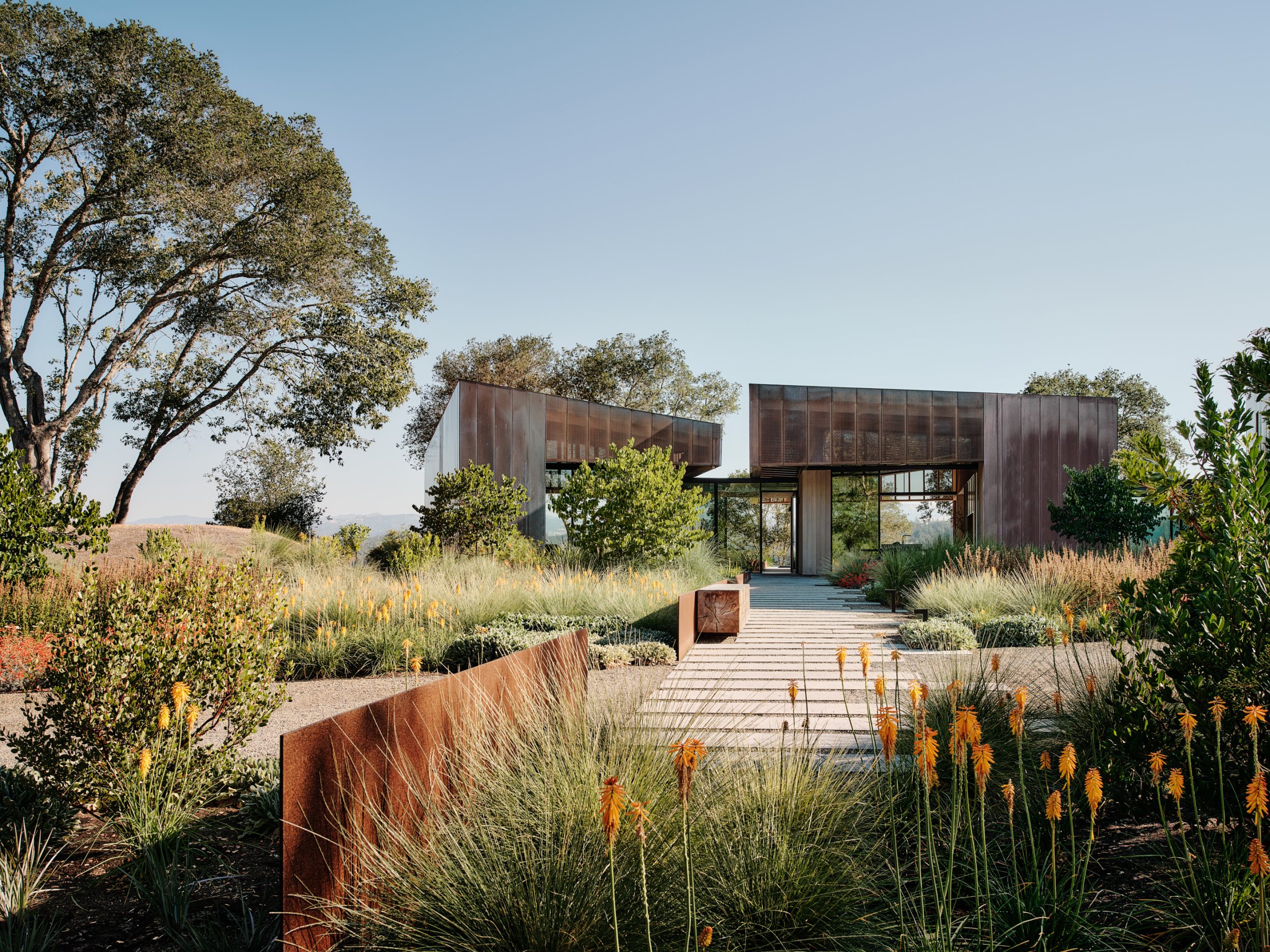Honor Award //project details Architect: Field Architecture Project Location: Sonoma County, CA Photographer: Joe Fletcher Madrone Ridge nestles into a forested promontory overlooking the valley below. Looking to the surrounding
The post Madrone Ridge appeared first on AIA California.
Madrone Ridge
//project details
Architect: Field Architecture
Project Location: Sonoma County, CA
Photographer: Joe Fletcher
Madrone Ridge nestles into a forested promontory overlooking the valley below. Looking to the surrounding landscape for inspiration, we aimed to allow the house to take form through its response to the surrounding environmental conditions of sun, wind, water, and fire. Rather than a central, clustered scheme, the house is composed of distributed spaces that reach into the landscape. Smaller, more dexterous “fragments” capture opportunities presented by the topographical and horticultural nuances of the site. These building elements host the various components of the program while allowing the structures to adapt to the natural terrain. With an increased surface area that folds inward and outward on itself, the house creates a sequence of intimate exterior spaces that connect us with the land.
//comments
This project’s pavilion organization is clearly expressed and detailed, and it is coupled with strong performance. | Skillfully done. | They used pre-fab components and reused materials, which doesn’t happen a lot in single-family residential. | The jury appreciated the resiliency consideration in material and system selection.
//framework for design excellence measures
Measure 1: Design for Integration
The project’s primary goal is to restore and enhance the natural environment that the home participates in. Site and landscape strategies are designed to connect plant communities and foster an ecologically productive landscape that is part of the larger regional ecology. The elements which give the building its form, are deliberately shaped by resilience to wildfire, seasonally optimized shading, passive heating and cooling, runoff prevention, and aquifer recharge. Together, these innovative strategies allow the home to operate in concert with the environmental cycles of the region, while providing comfort, refuge, and shelter for its occupants.
Measure 2: Design for Equitable Communities
The project aims to create interlocking sustainable water and food cycles. Water catchment troughs retain and dissipate rainwater from 100% of the roofed areas of the house and release it slowly back into the aquifer for recharge. Excess produce from a vegetable garden and fruit orchard is provided to local community food programs.
Measure 3: Design for Ecosystems
Surrounded by Oak and Madrone woodlands, the landscape integrates itself and rehabilitates previously cleared land. The architecture allows the landscape to come right up to the facade, and visually connects through the building. The owners live with the windows and doors open whenever possible and have grown in tune with the local wildlife—even becoming versed in the territorial habits of resident hummingbirds. Bird collision deterrence is improved by use of downturned roof edges outfitted with perforated metal screen. The screen provides low sun shading and allows natural ventilation, while creating a visible barrier that reduces collision threat.
Measure 4: Design for Water
Formally, the house is the result of a careful consideration of the elements that shape the surrounding context. Rooted in the relationship between water and earth, the roofs deliver water to the ground. Water collection has driven the design of the roofs so that each one forms a diagonal valley and channels rainfall to a single point. There, the water is gathered by a large rain chain in a visually dramatic moment where it is brought to a catchment area where it slows to allow aquifer recharge.
Measure 5: Design for Economy
A patio wrapping around the kitchen/living/dining room extends the space and provides a daily opportunity for immersion in the site’s ecosystems. Interior areas of the project were minimized to foster this engagement with the surrounding landscape, and the overall footprint was broken into smaller areas connected by walkways so that contiguous space for native habitat could be maximized. Hallways also serve as social areas, minimizing the need for additional rooms. Stairs similarly double as gathering spaces, featuring integrated seating/display. A flex room serving as a kids’ play room, gym, and family room is designed to change with the growing family.
Measure 6: Design for Energy
The project was sited and oriented for optimal solar orientation through the early use of an energy, daylighting, and thermal modelling. The skin was carefully studied and tuned to maximize daylight. Passive strategies such as using the floor for thermal mass was used in conjunction with active systems to optimize for a highly efficient home. The house is designed for net zero energy usage. No natural gas, and a small propane backup is offset with large battery storage system for continued operational capacity during grid outages.
Measure 7: Design for Well-Being
Models of the perforation and overhang were used to enhance the interior daylight. Solar orientation and shading was modeled and calibrated to achieve 98% optimization. Design creates direct connections to the outdoors by extending the facade beyond the glass to create comfortable and protected transitional outdoor spaces.
Measure 8: Design for Resources
The primary bedroom’s ceiling is clad is Brisco cross-laminated boards made from reclaimed plywood off-cuts. The roof package was prefabricated off site and provided by Spearhead; the unorthodox roof angles made this step crucial, so assembly was accurate and quick on site. Steel was minimized in the roof structure by maximizing glu-lam spans. All structural timber is FSC certified, the majority of which is recycled, engineered timber. Ceiling paneling throughout the home use recycled timber waste product, cross laminated to form panels which use a renewable material to sequester carbon and reduce waste.
Measure 9: Design for Change
In addition to earthquake and flood safety, the home specifically prioritized wildfire resilience. Innovative strategies were developed in collaboration with Cal Fire state representatives to develop an architecture that goes beyond the code minimum to express non-traditional ways of creating resilience. These include site planning, landscape interface, ignition resistance, building geometry, and a resilient envelope assembly incorporating Rockwool heat-stopping system clad in non-combustible copper skin. The landscape compliments this strategy with fire-resistant plantings and the house integrates itself into the landscape.
Measure 10: Design for Discovery
We aim to establish a culture of partnership between the designers, owners, and builders for the realization of an ambitious project vision. This team has been following up consistently since project completion in order to optimize performance and ensure that all project goals were met. The central design ambition was to use the building as a lens to discover and reveal the awesome character and nuance of the land. Rather than a singular strategy, our aim was to design all of the architectural elements as adaptations to the site which reveal and celebrate its ecological function and beauty.
The post Madrone Ridge appeared first on AIA California.
AIA CaliforniaRead More





